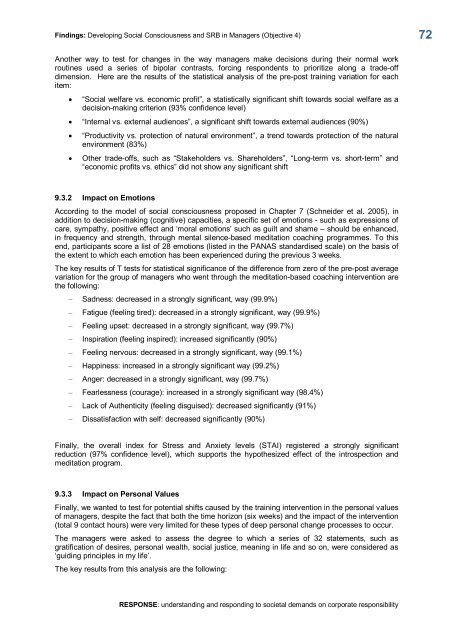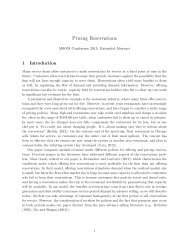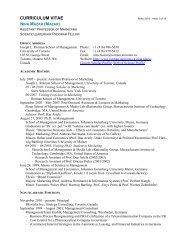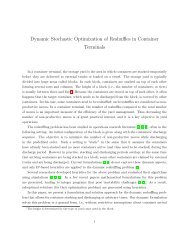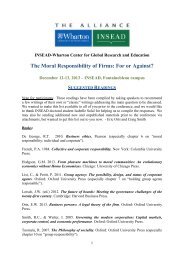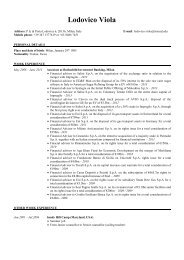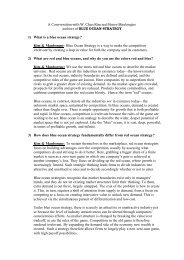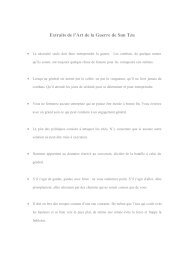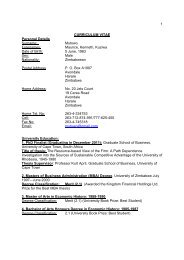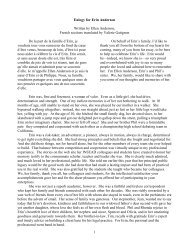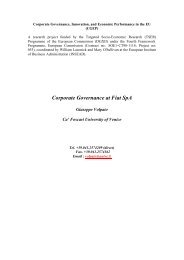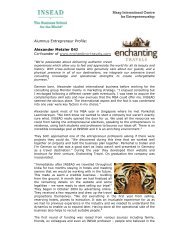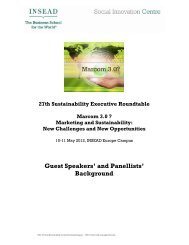RESPONSE - Insead
RESPONSE - Insead
RESPONSE - Insead
Create successful ePaper yourself
Turn your PDF publications into a flip-book with our unique Google optimized e-Paper software.
Findings: Developing Social Consciousness and SRB in Managers (Objective 4)<br />
Another way to test for changes in the way managers make decisions during their normal work<br />
routines used a series of bipolar contrasts, forcing respondents to prioritize along a tradeoff<br />
dimension. Here are the results of the statistical analysis of the prepost training variation for each<br />
item:<br />
• “Social welfare vs. economic profit”, a statistically significant shift towards social welfare as a<br />
decisionmaking criterion (93% confidence level)<br />
• “Internal vs. external audiences”, a significant shift towards external audiences (90%)<br />
• “Productivity vs. protection of natural environment”, a trend towards protection of the natural<br />
environment (83%)<br />
• Other tradeoffs, such as “Stakeholders vs. Shareholders”, “Longterm vs. shortterm” and<br />
“economic profits vs. ethics” did not show any significant shift<br />
9.3.2 Impact on Emotions<br />
According to the model of social consciousness proposed in Chapter 7 (Schneider et al. 2005), in<br />
addition to decisionmaking (cognitive) capacities, a specific set of emotions such as expressions of<br />
care, sympathy, positive effect and ‘moral emotions’ such as guilt and shame – should be enhanced,<br />
in frequency and strength, through mental silencebased meditation coaching programmes. To this<br />
end, participants score a list of 28 emotions (listed in the PANAS standardised scale) on the basis of<br />
the extent to which each emotion has been experienced during the previous 3 weeks.<br />
The key results of T tests for statistical significance of the difference from zero of the prepost average<br />
variation for the group of managers who went through the meditationbased coaching intervention are<br />
the following:<br />
– Sadness: decreased in a strongly significant, way (99.9%)<br />
– Fatigue (feeling tired): decreased in a strongly significant, way (99.9%)<br />
– Feeling upset: decreased in a strongly significant, way (99.7%)<br />
– Inspiration (feeling inspired): increased significantly (90%)<br />
– Feeling nervous: decreased in a strongly significant, way (99.1%)<br />
– Happiness: increased in a strongly significant way (99.2%)<br />
– Anger: decreased in a strongly significant, way (99.7%)<br />
– Fearlessness (courage): increased in a strongly significant way (98.4%)<br />
– Lack of Authenticity (feeling disguised): decreased significantly (91%)<br />
– Dissatisfaction with self: decreased significantly (90%)<br />
Finally, the overall index for Stress and Anxiety levels (STAI) registered a strongly significant<br />
reduction (97% confidence level), which supports the hypothesized effect of the introspection and<br />
meditation program.<br />
9.3.3 Impact on Personal Values<br />
Finally, we wanted to test for potential shifts caused by the training intervention in the personal values<br />
of managers, despite the fact that both the time horizon (six weeks) and the impact of the intervention<br />
(total 9 contact hours) were very limited for these types of deep personal change processes to occur.<br />
The managers were asked to assess the degree to which a series of 32 statements, such as<br />
gratification of desires, personal wealth, social justice, meaning in life and so on, were considered as<br />
‘guiding principles in my life’.<br />
The key results from this analysis are the following:<br />
<strong>RESPONSE</strong>: understanding and responding to societal demands on corporate responsibility<br />
72


